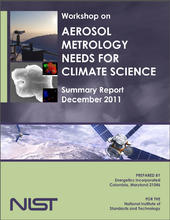Carbon Aerosol Research Projects
The NIST Greenhouse Gas Measurements Program supports researchers and collaborators as they work to advance our understanding of carbonaceous aerosols, including the direct and indirect radiative forcing effects of black carbon and organic aerosol particulates. This program aims to advance measurement capabilities for black carbon optical properties, improve methods for referencing material development and dissemination, and explore new instrumentation and characterization techniques.

|
Methods and Standards for Measurement of Atmospheric Aerosol Radiative Properties – (C. Zangmeister and M. Zachariah, Materials Measurement Lab) Goal: to develop methods that facilitate the measurement of aerosol optical properties, apply these measurements to relevant atmospheric systems that improve models of radiative forcing, and develop a transferrable aerosol with known optical properties. |

|
Carbonaceous Aerosol Measurements – (M. Zachariah and C. Zangmeister, MML) Goal: to develop methods to decrease the uncertainty in the measurement of particle size, size distribution and shape in order to enable higher fidelity field measurements. In particular improve the accuracy of nanoparticle measurement for standards applications, and extend measurements to provide on-the-fly shape and chemical information. |
|
|
Heterogeneous Atmospheric Dust: Individual Particles Microanalysis Optical Property Modeling and Lab-Generated Particle Analogs – (J. Conny, MML) Goal: to determine the natural variation in optical properties of heterogeneous aerosols based on microanalysis of selected individual particles. |

|
Secondary Organic Aerosols – (S. McGivern, MML) Goal: to identify and characterize chemical processes that affect the interaction of atmospheric organic aerosols with incoming solar radiation. |
|

|
Read a summary report of the 2011 Aerosol Metrology for Climate Workshop (PDF) |
Contacts
Created December 16, 2014, Updated January 4, 2023


